#resistor arrays
Explore tagged Tumblr posts
Text
What are some common configurations of resistor arrays?
Resistor arrays come in various configurations to suit different circuit designs and requirements. Here are some common ones:
Equal Value Arrays: These arrays consist of several resistors of the same value connected in parallel or series. They're handy for applications where multiple resistors of identical values are needed.
Voltage Divider Arrays: These arrays are configured to divide voltage in a circuit. They typically consist of two resistors connected in series, with the output voltage taken from the junction between them. They're useful for creating reference voltages or for signal conditioning.
Pull-up and Pull-down Arrays: These arrays are used in digital circuits to ensure a stable logic level when an input is left unconnected. Pull-up arrays connect a resistor to a positive voltage source, while pull-down arrays connect a resistor to ground. They prevent floating inputs and ensure reliable operation.
Termination Arrays: In high-speed digital circuits, termination arrays are used to match impedance and reduce signal reflections. They typically consist of several resistors arranged in parallel and placed at the end of a transmission line.
Network Arrays: These arrays combine resistors in various configurations, such as series-parallel networks, to achieve specific impedance or attenuation characteristics. They're commonly used in filter circuits and impedance matching networks.
0 notes
Text
What is a resistor, resistor network, high power resistor, resistor array chip
CRCW Series 0805 300 Ohm ±5% 0.5 W ±100 ppm/K SMT Thick Film Chip Resistor
0 notes
Text
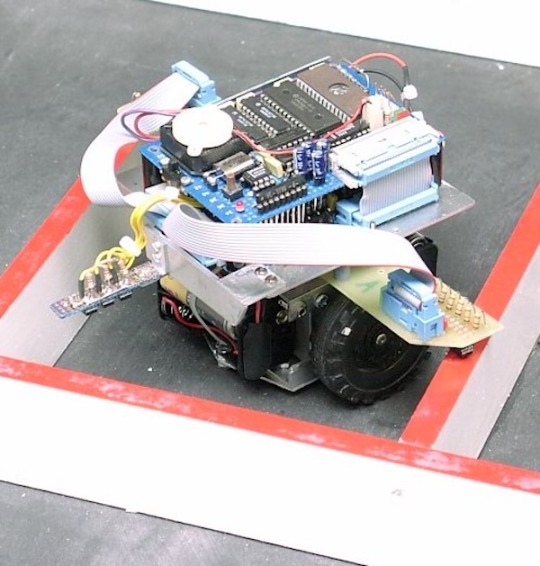



Hector (2001) by Wayne Allen, UK. Hector is a left-hand wall follower that first competed at Minos 2002.
"Hector consists of two wire wrapped boards mounted above two hybrid stepper motors. The boards are connected by a 20 way IDC connection. The upper board holds the microprocessor, a motorola 68HC11E9, RAM (8K), ROM (32K) and various decode logic. because the design was not complete before construction began two chips had to be mounted in a rather unconventional manner, one is mounted under the RAM chip, whist the other is soldered on its side under the board. The lower board holds the heat sink, the power regulator and the two motor drive IC's (L298s). Both boards are mounted via stand offs on the chassis, basically a 2mm aluminum plate bolted directly to the motors. The underside of the chassis is fitted with two screw heads, with a bit of slider from a PC mouse super glued on - the idea was to produce a low friction support… it worked until it fell off!
Power was initially supplied via 6 AA (800mAh) nicads and a PP3 (see pictures). This provided around 10 minutes of operation. The PP3 was soon dropped as the mouse did not suffer from the reset problem that Boris had. However the running time was still a serious limitation. Subsequently the AA's were replaced with 6 sub C's… 2000mAh each!!
Wall detection is achieved by arrays of IR detector/emitters, mounted looking down on the top of the wall. The PCB's were made in my kitchen sink, much to the chagrin of my flat mates. Each array of 8 were switched as a set, in an attempt to save power. Unfortunately I build the wings on the wrong side of the transistor switch and they ended up pulling around 10mA. I then removed the switching system and lowered the drive resistors, resulting in a full array pulling around 160mA. (each IR emitter is running @ 20mA). Front walls are detected with a smaller array."
4 notes
·
View notes
Text
Uh.
Does youTube degrade the quality of older videos? Or did I really watch this "ING New York City Marathon course video" like 55 times back in 2006 and never notice that it was filmed using an array of photo resistors duck-tapped together and hilariously sold to someone as a "camera"?
I guess ubiquitous HD video has me pretty spoiled.
IDK if I'll be able to train up to doing it, but before I didn't know if I'd run at all again.
My leg feels … interesting.
youtube
77 notes
·
View notes
Text
Title: "TWCT-T-D55: The Sorcerer’s Wand of Current Sensing"
In the shadowy corridors of the Muggle industrial realm, where currents surge like Hungarian Horntails and circuits hum with the secrets of the Forbidden Forest, there exists a device of unparalleled enchantment—the TWCT-T-D55 Current Transformer. Much like the Elder Wand, it bends the wildest currents to its will, transforming 200A of electrical chaos into a mere 5A whisper. Let us unveil its magic.

Chapter 1: The Wand Chooses the Wizard
The TWCT-T-D55 is no ordinary Probe Spell. Crafted with the precision of a Time-Turner and the resilience of a Shield Charm, this 200/5A CT operates under Class 1 Accuracy—a feat even Hermione Granger’s Arithmancy notes would envy. Its core? A 5VA burden rating, lighter than a feather plucked from Fawkes himself.
Why it outshines the Muggle-made:
Traditional CTs: Clumsy as a troll in the Astronomy Tower, their ±3% inaccuracy could misread a Thestral’s flight path.
Shunt Resistors: A dark art best left to amateurs. One misstep, and your circuitry becomes as charred as a Weasley’s failed Floo Powder experiment.
Chapter 2: The Triwizard Tasks of TWCT-T-D55
1. Taming the Hungarian Horntail (Factory Floors): When 200A machinery roars like a dragon in Gringotts, the TWCT-T-D55 casts a Silencing Charm. Install it on assembly lines to detect “energy Dementors” sucking power faster than a Dementor’s kiss. Savings? Enough Galleons to buy a Firebolt fleet.
2. Guardian of the Solar Sorcery (Photovoltaic Arrays): Beneath blazing suns or hail storms worthy of Auror training, this CT channels sunlight into grids smoother than a Patronus cutting through darkness.
3. The Knight Bus of EV Chargers: Monitors Tesla Superchargers without the Exploding Snap risk. Detects faults faster than Mad-Eye Moody spots an Imperius curse.
The Ministry’s Scroll of Truth (Market Data)
MetricTWCT-T-D55Muggle CTsSize Fits in a Niffler’s pouch (55mm) Bulky as Hagrid’s umbrella Installation Time 8 minutes (a Hufflepuff’s tea break) 30 minutes + a S.P.E.W. manifesto Accuracy ±1% (Snitch-catching precision) ±3% (Goblin-made scales, circa 1492)
The Dark Arts (Limitations)
No Owl Post Upgrades: Cannot send Hogwarts acceptance letters (yet).
Invisibility Cloak Needed: Too discreet for a Weasley fireworks show.
The Prophecy Unfolds
Hogwarts 2.0 (Smart Grids): Paired with Divination-grade AI, TWCTs predict grid failures before Trelawney finishes her sherry.
Order of the Phoenix (Space Missions): NASA seeks radiation-hardened TWCTs for Mars colonies—because even astronauts need protection from Venomous Tentacula currents.
Epilogue: A Spellbinding Choice To ignore the TWCT-T-D55 is to face the Chamber of Energy Waste alone. Choose wisely, for as Dumbledore once said: “It is our choices that show what we truly are, far more than our abilities.”
References
Advanced Guide to Industrial Charms (Ministry of Energy, 2024)
The Tales of Solar Beedle the Bard (Renewable Grid Press)
Hogwarts: A History of Magical Engineering (Ilvermorny Editions)
2 notes
·
View notes
Text
DIRTY DRONE LOWLIFE - a subbass / drone / noise texture generator
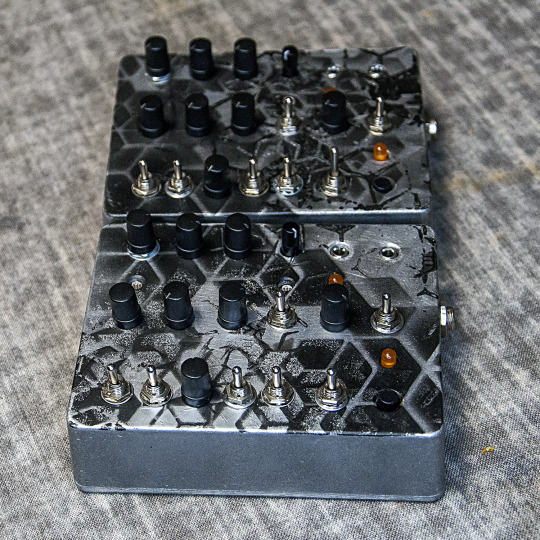
The Dirty Drone Lowlife is an experimental subbass and drone texture generator. It can be manually triggered by a TRIGGER button and externally with a TRIGGER/GATE input. The DECAY has a SHORT/LONG switch to select the range and a DECAY pot to fine tune it, from snappy to loooong. An orange LED indicates triggers and the decay (only dim with short triggers on long decay settings). With the DRONE toggle switch it can be set to play a constant drone sound as well. The sound's waveform is generated by two oscillators each with an array of possible settings: TRIANGLE/SQUARE and CLEAN/DIRTY toggle switches and of course a FREQUENCY control. Oscillator 1 has an additional OFFSET control, that can (in the range from 1.6V-2.6V) also get modulated by external control voltage via the CV input (with an orange indicator LED). Both oscillators are mixed with the BLEND control, that allows to shape the output waveform in a relatively linear manner, but the build in LDRs (Light Dependent Resistors) can also be used for that, when they are selected with the BLEND SELECT toggle switch, the user can ‘throw shade’ or ‘shine light’ on the build in sensors for a non-linear modulation of the oscillator BLEND. so it is possible to modulate the sound by hand gestures, for example. After that the signal runs through a resonant low pass filter with CUTOFF FREQUENCY, RESONANCE and SATURATION control. (please, keep in mind that in trigger mode it does not get completely quiet with no trigger.) In the end of the signal chain is a VOLUME control. Build into a die-cast aluminum enclosure painted with an unique 'burned out industry' camo pattern. Power-socket: 9V DC , 2,1mm DC jack boss-style (inside -/+ outside) PSU is NOT included. Handmade by GRM for METSÄÄN. Sold. Here’s demovideo of a previous build:
youtube
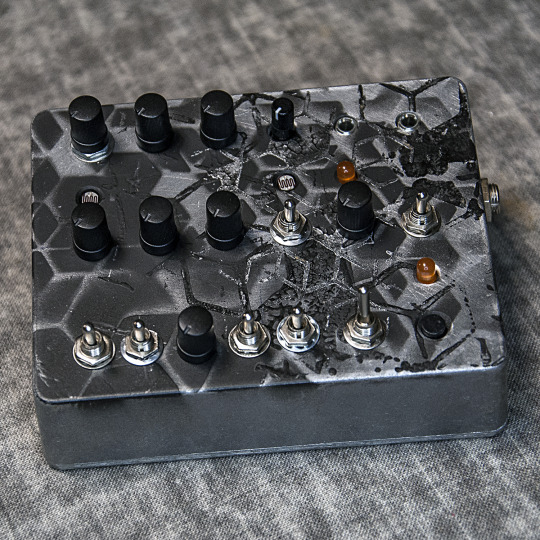
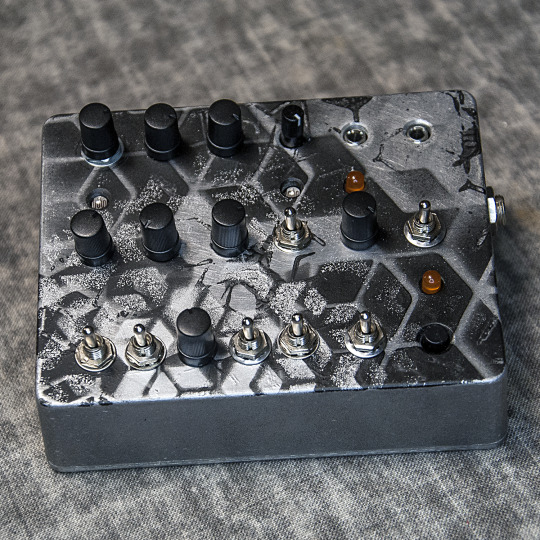
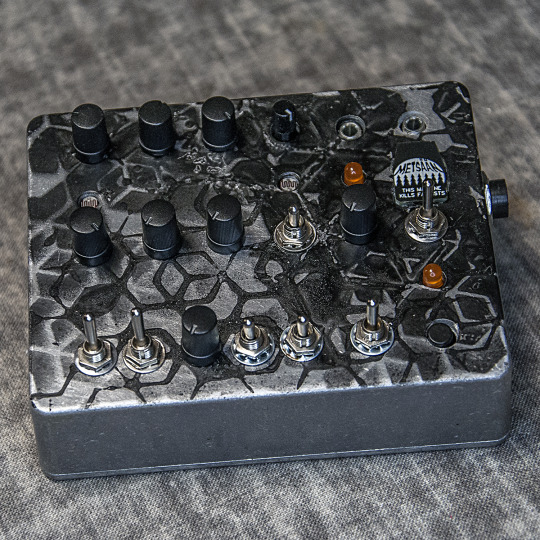
2 notes
·
View notes
Text
Lingshan Hermit: The Choice of a Ruler
On a frigid winter morning in 1636 AD, as the king of Joseon looked out from the fortress walls of Namhansanseong, he saw the endless snow-covered mountains stretching into the distance, the yellow tents of Manchu Emperor Hong Taiji atop the mountain peaks, and the tribal soldiers of the barbarians occupying the hills and valleys as far as the eye could see. As the sovereign of Joseon, he had been in refuge here for months. Within these fortress walls were just over ten thousand soldiers and common folk left. Food was dwindling away, people had begun slaughtering war horses to fend off starvation, and there was still no sign of the legendary royal army coming to their aid. The troops were already starving and freezing in the harsh winter, and a sense of hopelessness had settled upon the people in this bitter cold.
The Manchu army had marched on Joseon in 1636 to punish the Joseon dynasty for refusing to acknowledge Manchu legitimacy, and to force their submission by military might. For the Joseon king and his court, surrendering to these barbarians who had only just emerged from the Siberian forests would be unimaginable humiliation. Raised under Confucian teachings, wearing Ming dynasty robes and using Ming writing, Joseon saw itself as a great tributary state of the mighty Ming Empire. Yet the overwhelming military force arrayed against them confronted the Joseon leadership with an extreme choice - surrender or be killed. Endless debates ensued between those involved in the decision. One faction argued that righteousness was more important than life itself, and that the king should choose death before dishonor. The other contended that without life, righteousness was meaningless, so for the sake of preserving the nation, the king should submit to the barbarians. Those with modern educations might find such debates unbelievable, as they would choose life without hesitation, dismissing righteousness as intangible and abstract. But it is difficult for them to fully appreciate the weight these concepts carried for those raised under Confucianism. As you all know me, I am not one to be enslaved by modern notions - I have always believed modern thinking to be regressive. As I've said, I am an ancient man of today - I do not consider righteousness and integrity to be intangible things. On the contrary, I believe them to be quite important. However, if asked whether righteousness or life should be chosen in such dire circumstances, it is not straightforward to answer. Sometimes, righteousness is more important than life, while at other times, life takes priority over righteousness. It depends on whether you still have important work left to accomplish, and whether the impact of that work is significant enough for you to endure tremendous humiliation and responsibility in order to go on living. If you have sufficient cause and duty to survive, then you should do so. If not, then yes, righteousness takes priority, for reincarnation is real. In the film The Fortress, the final choice of Joseon was the humiliating path of survival. The Joseon king groveled before Manchu Emperor Hong Taiji, enduring tremendous shame in performing the ritual of three kneelings and nine prostrations.
Just a few years later, the Chinese also faced the same excruciating choice when Manchu troops defeated Li Zicheng in 1644, marched into Beijing, and brought an end to the last ethnic Han Chinese dynasty. The very next year after occupying the Forbidden City, they instituted the Queue Order, requiring all Han Chinese men to adopt Manchu hairstyles and dress. As expected, this decree enraged the entire Chinese populace, sparking countless acts of defiant resistance. Countless resistors were killed under the brutal repression that followed, and those who survived were left with no choice but to abandon a hairstyle tradition thousands of years old in order to survive. There are hardly any films depicting this profoundly important historical event.
In 1636, the Joseon king had no choice but to kowtow before the barbarian emperor to preserve himself and his people. His son was taken hostage to Shenjing, hundreds of thousands of his people were captured and sold into slavery, and he had to endure humiliation and learn how to live under the enemy's tyranny. Many great figures in human history have done the same, because they knew the nightmare would eventually pass, and that their survival meant something to the world. They knew who they were, why they were there, and what deeds they had yet to accomplish. They understood the significance of their work to the entire world, that these tasks had to be completed by them, so they chose to live on and bear it all.
In the pivotal Battle of Yamen in 1279, the Mongol army thoroughly destroyed the final stronghold of the Song dynasty, driving the hundreds of thousands of Song soldiers and civilians alike into the sea. The last Song emperor Zhao Bing drowned himself in the waters. According to historical records, a soldier surnamed Chen was fished from the sea after that major naval engagement. He later settled in Weiyang, Jiangsu province and lived over ninety years. He raised two daughters, the second of whom married a man named Zhu Shizhen. Their son Zhu Chongba became the founding emperor of the Ming dynasty, leading armies to drive the Mongols back to the northern steppes. Sometimes, survival is crucial, while at other times, righteousness takes priority. For the Song emperor to drown himself in that world-shocking naval battle was the right choice, just as it was also right for the soldier who survived not to then commit suicide. Each fulfilled his own purpose.
Written by Lingshan Hermit, May 4, 2022
灵山居士:国君的选择
5 notes
·
View notes
Text
What is FPGA & Why It’s Important for ECE Students?

As an Electronics & Communication Engineering (ECE) student, you must have heard the term FPGA a couple of times. But what exactly is it? Why is everyone talking about it? And most importantly, what does it do for you in your professional life? Well, let’s break it down in the easiest possible manner.
In the modern tech world, electronics is no longer about wires & resistors. The field has expanded & it now encompasses advanced systems such as embedded processors, IoT devices & digital logic designs. And that is where FPGA for ECE students comes in as a lifesaver. Studying FPGA can provide you with a solid advantage, particularly if you intend to work in electronics, robotics, chip design or embedded systems.
What is FPGA in Electronic Engineering?
FPGA is short for Field-Programmable Gate Array. In simple terms, it’s a digital chip that can be programmed after manufacturing. Unlike standard processors (such as the one in your PC), which have pre-programmed functions, FPGAs can be reprogrammed to do many different things.
The good thing about FPGA is that you can create your own logic circuits on it such as creating a tiny processor or creating a custom system tailored to your requirements. This is what makes FPGAs so great in the world of electronics so when someone asks what is FPGA in electronic engineering, they’re referring to a device that allows engineers to create digital systems from the ground up, all in a single chip.
Why Is FPGA Important for ECE Students?
Being an ECE student, you’re supposed to understand how electronic systems operate — not only theoretically but practically as well. This is where FPGA for ECE students comes into the picture. With FPGA, you don’t merely study logic gates or flip-flops; you build systems that use them.
This hands-on experience teaches you about digital design in depth. You get to see how signals travel, how timing occurs & how circuits actually function in the real world. This is something that textbooks can’t teach yet it’s exactly what employers are seeking when they hire.
Other than this, here’s why FPGA is important for ECE students:
• Boosts Practical Knowledge & Skills
FPGAs are commonly used in industries such as telecommunication, defence, medical electronics & consumer equipment. So, becoming familiar with working with FPGA provides practical skills. You will learn about tools such as VHDL or Verilog (for programming FPGA) & simulation tools like Xilinx or Altera.
When you have FPGA for ECE students in your resume, it proves that you not only know theory but can also design & test actual systems. This differentiates you from others at the time of internships, interviews & placements.
• Opens Up Career Opportunities in Core Electronics
One of the big benefits of studying FPGA is that it leads to core electronics career opportunities. Most ECE students end up in IT or software jobs since they don’t have hands-on experience with hardware. But with a good knowledge of FPGA, you can target jobs in embedded systems, VLSI design, robotics, or even the aerospace industry.
Also read: https://bfitgroup.in/fpga-and-its-importance-for-ece-students/
0 notes
Text
DCG3 Headphone Amplifier and Preamplifier: High-End Analog Performance with Premium Components
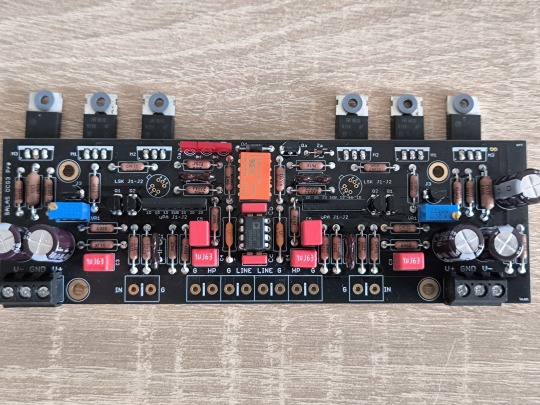
If you're in search of a reference-class headphone amplifier and preamplifier, the DCG3 should be at the top of your list. Designed with a clear focus on sonic purity and engineering excellence, the DCG3 delivers outstanding audio performance, thanks to a carefully selected array of audiophile-grade components and a robust circuit design.
Audiophile-Grade Input Stage with NEC uPA68H JFETs
At the heart of the DCG3’s input stage is the dual JFET uPA68H from NEC, a high-performance device known for its clean, musical sound signature that closely resembles the legendary 2SK170. The biasing for the JFETs is handled by a BF256 operating at approximately 5mA, ensuring optimal linearity and thermal stability.
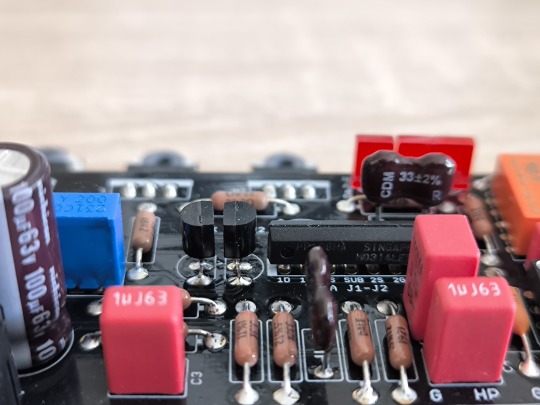
Premium Build with High-End PCB and Components
The DCG3 is built on a black, 2mm thick PCB with 2oz copper for enhanced current handling and thermal performance. Measuring 160 x 50 mm, the board layout is optimized for minimal signal path length and maximum shielding from noise.
Only the best components were selected for the DCG3 to ensure superior sound quality and long-term reliability:
Vishay Dale CMF series resistors for critical signal paths and CPF for power handling
Nichicon electrolytic capacitors for smooth, noise-free power delivery
WIMA film capacitors known for their precision and low distortion
Cornell Dubilier silver mica capacitors, revered for their exceptional stability and clarity in audio circuits
Advanced Output Section with Delayed Relay Protection
The DCG3 features both line output and headphone output, each protected by a miniature NEC EA2-12NJ relay that provides delayed engagement to eliminate pops and protect connected gear.
An integrated DC servo circuit based on the AD823 operational amplifier eliminates any DC offset at the output, further improving safety and sound fidelity.
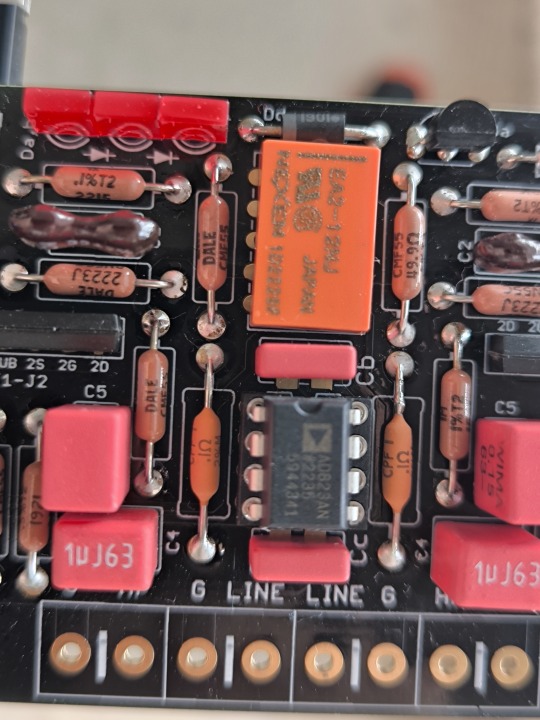
Output Stage with Vishay MOSFETs and Precision Design
The output stage utilizes robust Vishay IRF9610 and DN2540 MOSFETs, chosen for their linear performance and durability. The amplifier operates at a gain of 3x, offering just the right level of amplification for most line-level sources and headphones.
The quiescent current is set to 120mA, providing ample headroom and drive capability for a wide range of headphones, while maintaining excellent thermal behavior.
Exceptional Noise Performance and Low Output Impedance
The DCG3 achieves an impressive -120 dBV noise floor, making it virtually silent in operation. Output impedance is optimized for both outputs:
Line out impedance: 50 ohms
Headphone out impedance: less than 0.1 ohm
This ensures excellent damping factor and tight bass control, especially for low-impedance headphones.
Power Supply: SSLV1.3 UltraBiB Shunt Regulator
To match the sonic performance of the DCG3, it is powered by the SSLV1.3 UltraBiB shunt regulator, a low-noise, high-speed power supply known for its excellent transient response and ultra-clean output. This regulator was covered in detail in our previous article, and it plays a crucial role in enabling the DCG3 to reach its full potential.
Conclusion: A True Reference-Grade Headphone Amplifier
The DCG3 headphone amplifier and preamplifier is a testament to precision analog engineering. With its carefully matched components, optimized circuit design, and impeccable power delivery, it is ideal for demanding audiophiles who seek transparent, dynamic, and musically engaging sound.
Whether used as a standalone headphone amp or integrated into a high-end stereo system, the DCG3 delivers exceptional clarity, low distortion, and true reference performance.
0 notes
Text
0 notes
Text
Resistor Network & Array Market: Analysis by Type, End-Use, and Region
Resistor Network & Array Market Analysis:
The Resistor Network & Array Market was valued at USD 1.28 billion in 2024 and is projected to reach USD 1.86 billion by 2032, growing at a CAGR of 4.80% during the forecast period (2025-2032).
Resistor Network & Array Market Overview
Resistor networks and arrays are electronic components that integrate multiple resistors into a single compact package. These devices simplify circuit design by reducing the number of discrete components required and improve circuit reliability through consistent resistor characteristics.
A resistor network typically consists of several individual resistors connected in a predefined manner—such as series, parallel, or mixed configurations—within one package. An array, on the other hand, often refers to multiple resistors arranged in a matrix or pattern designed for specific circuit functions.
These components are used primarily to provide resistance in electronic circuits for current limiting, voltage division, signal conditioning, and termination. Their applications span across various sectors, including:
Industrial electronics, for automation controllers and instrumentation.
Medical devices, where miniaturization and reliability are critical.
Consumer electronics, such as smartphones, tablets, and wearables.
Automotive electronics, including engine control units, sensors, and infotainment systems.
The key benefits of resistor networks and arrays include space-saving design, reduced assembly complexity, improved matching and tolerance among resistors, and enhanced thermal management. These advantages make them essential components in modern electronic manufacturing.
This report provides a deep insight into the global Resistor Network & Array Market, covering all its essential aspects. This ranges from a macro-overview of the market to micro details of the market size, competitive landscape, development trend, niche market, key market drivers and challenges, SWOT analysis, value chain analysis, etc.
The analysis helps the reader to shape the competition within the industries and strategies for the competitive environment to enhance the potential profit. Furthermore, it provides a simple framework for evaluating and assessing the position of the business organization. The report structure also focuses on the competitive landscape of the Global Resistor Network & Array Market. This report introduces in detail the market share, market performance, product situation, operation situation, etc., of the main players, which helps the readers in the industry to identify the main competitors and deeply understand the competition pattern of the market.
In a word, this report is a must-read for industry players, investors, researchers, consultants, business strategists, and all those who have any kind of stake or are planning to foray into the Resistor Network & Array Market in any manner.
Resistor Network & Array Key Market Trends :
Increasing Demand in Automotive Sector: The growing adoption of advanced electronic systems in vehicles is boosting the demand for resistor networks and arrays.
Miniaturization of Electronic Devices: There is a trend toward smaller and more compact devices, driving the need for integrated resistor networks to save space.
Rising Industrial Automation: Expansion of automation and smart factories is increasing the use of resistor arrays in industrial applications for efficient circuit designs.
Growing Medical Electronics Market: The rise in medical devices requiring precision components supports the growth of resistor networks.
Expansion in Asia-Pacific Market: Rapid industrialization and electronics manufacturing in Asia-Pacific, especially China and South Korea, is driving regional market growth.
Resistor Network & Array Market Regional Analysis :
North America:Strong demand driven by EVs, 5G infrastructure, and renewable energy, with the U.S. leading the market.
Europe:Growth fueled by automotive electrification, renewable energy, and strong regulatory support, with Germany as a key player.
Asia-Pacific:Dominates the market due to large-scale manufacturing in China and Japan, with growing demand from EVs, 5G, and semiconductors.
South America:Emerging market, driven by renewable energy and EV adoption, with Brazil leading growth.
Middle East & Africa:Gradual growth, mainly due to investments in renewable energy and EV infrastructure, with Saudi Arabia and UAE as key contributors.
Resistor Network & Array Market Segmentation :
The research report includes specific segments by region (country), manufacturers, Type, and Application. Market segmentation creates subsets of a market based on product type, end-user or application, Geographic, and other factors. By understanding the market segments, the decision-maker can leverage this targeting in the product, sales, and marketing strategies. Market segments can power your product development cycles by informing how you create product offerings for different segments.
Market Segmentation (by Application)
Industrial
Medical
Electronics
Automotive
Others
Market Segmentation (by Type)
Network
Array
Key Company
Analog Devices
AVX Corporation
Bourns
CTS Corporation
Murata Manufacturing
Panasonic
Rohm
Susumu
SparkFun Electronics
TE Connectivity
Vishay
Ohmite
Kamaya
Maxim Integrated
Honeywell
KOA Speer
Royalohm
TT Electronics
Walsin
Xicon
Drivers
Rising Electronics Production: Increasing manufacturing of consumer electronics, automotive electronics, and medical devices fuels the demand for resistor networks.
Technological Advancements: Innovations in materials and manufacturing processes improve performance and reliability, attracting more applications.
Cost Efficiency: Resistor networks and arrays reduce overall circuit complexity and cost, making them preferred choices in many industries.
Restraints
Supply Chain Disruptions: Global supply chain issues can delay production and increase component costs, affecting market growth.
Alternative Technologies: The emergence of new circuit components and technologies may limit the adoption of traditional resistor networks.
Stringent Regulatory Standards: Compliance with various regional standards and certifications may increase manufacturing costs and complexity.
Opportunities
Growth in IoT Devices: Expansion of IoT applications requires compact and efficient resistor solutions, opening new market segments.
Emerging Markets: Developing countries offer untapped potential due to increasing electronics consumption and industrialization.
Customization Demand: Increasing preference for customized resistor networks tailored to specific applications creates growth opportunities for manufacturers.
Challenges
Price Volatility of Raw Materials: Fluctuating costs of raw materials like metals can affect pricing and profitability.
High Competition: Intense competition among established players pressures margins and demands continuous innovation.
Technological Obsolescence: Rapid technology evolution requires constant upgrades and R&D investment to stay relevant.
Related Reports:https://semiconductorblogs21.blogspot.com/2025/06/global-gaas-power-amplifier-market.htmlhttps://semiconductorblogs21.blogspot.com/2025/06/ambient-light-sensor-for-display-system.htmlhttps://semiconductorblogs21.blogspot.com/2025/06/solar-obstruction-light-market-to-reach.htmlhttps://semiconductorblogs21.blogspot.com/2025/06/ac-dc-power-supply-converter-market-to.htmlhttps://semiconductorblogs21.blogspot.com/2025/06/boost-charge-pump-ics-market-to-reach.htmlhttps://semiconductorblogs21.blogspot.com/2025/06/global-motion-detector-sensor-market-to.htmlhttps://semiconductorblogs21.blogspot.com/2025/06/x-ray-inspection-for-security-market-to.htmlhttps://semiconductorblogs21.blogspot.com/2025/06/global-spatial-filters-market-to-reach.htmlhttps://semiconductorblogs21.blogspot.com/2025/06/global-e-beam-liner-market-advancements.htmlhttps://semiconductorblogs21.blogspot.com/2025/06/global-active-quartz-crystal-oscillator.htmlhttps://semiconductorblogs21.blogspot.com/2025/06/global-ultrasonic-radar-market-share.htmlhttps://semiconductorblogs21.blogspot.com/2025/06/global-ammeter-shunt-resistors-market.htmlhttps://semiconductorblogs21.blogspot.com/2025/06/global-wifi-and-bluetooth-rf-antenna.htmlhttps://semiconductorblogs21.blogspot.com/2025/06/global-industrial-control-printed.htmlhttps://semiconductorblogs21.blogspot.com/2025/06/global-scanning-transmission-electron.html
0 notes
Text
Trump's odious corruption
GIVE THE TIMESAccount
Opinion
Trump’s Biggest Beneficiary: Himself
Listen to this article · 9:13 min Learn more
Share full article
By Steven Rattner
Mr. Rattner, a contributing Opinion writer, was counselor to the Treasury secretary in the Obama administration.
No presidential administration is completely free from questionable ethics practices, but Donald Trump has pushed us to a new low. He has accomplished that by breaking every norm of good government, often while enriching himself, whether by pardoning a convicted felon who, together with his wife, donated $1.8 million to the Trump campaign; promoting Teslas on the White House driveway; or holding a private dinner for speculators who purchase his new cryptocurrency.
Mr. Trump’s blatant transgressions have swamped those of any modern president and even those of his first term. Remember the outrage when he refused to divest his financial holdings or when he used a Washington hotel he owned as a kind of White House waiting room? Those moves seem quaint in comparison.
In his trampling of historically appropriate behavior, Mr. Trump appears to be pursuing several agendas. Personal enrichment stands out: Imagine any other president collecting a cut of sales from a cryptocurrency marketed with his likeness. There is the way he is expanding his powers: He has ignored or eliminated large swaths of rules that would have inhibited his freedom of action and his ability to put trusted acolytes in key roles. And then there’s rewarding donors, whether through pardons or favors for their clients.
Sign up for the Opinion Today newsletter Get expert analysis of the news and a guide to the big ideas shaping the world every weekday morning. Get it sent to your inbox.
I was working in the Washington bureau of The Times when Richard Nixon resigned, and even he — taken down by his efforts to cover up his misdeeds — did not engage in such a vast array of sordid practices.
The corruption of Trump 2.0 has not gotten the attention it deserves amid the barrage of news about Mr. Trump’s tariff wars, his attack on scientific research and his senior appointees’ Signal text chains. But self-dealing is such a defining theme of this administration that it needs to be called out. Like much that Mr. Trump has done in other areas, it announces to the world that America’s leaders can no longer be trusted to follow its laws and that influence is up for sale.
Just as in the post-Nixon era, when guardrails were established to prevent transgressions, the next president could decide to restore some of the sound government practices that Mr. Trump has trampled on. But the damage he has inflicted by, say, pardoning his donors or lining his own pockets is irreversible.
The below represents just a sampling of what’s transpired these past 100 days.
He Eliminated Guardrails
He turned a legitimate federal employee designation into a loophole. By giving senior officials such as Elon Musk the title “special government employee,” Mr. Trump avoided requirements that they publicly disclose their financial holdings and divest any that present conflicts before taking jobs in the administration.
He ended bans that stopped executive branch employees from accepting gifts from lobbyists or seeking lobbying jobs themselves for at least two years.
He loosened the enforcement of laws that curb foreign lobbying and bribery.
He Fired Potential Resistors
He dismissed the head of the office that polices conflicts of interest among senior officials.
He jettisoned the head of the office that, among other things, protects whistle-blowers and ensures political neutrality in federal workplaces.
He purged nearly 20 nonpartisan inspectors general who were entrusted with rooting out corruption within the government.
He Rewarded His Wealthiest Donors
Rewarding donors is part of any presidential administration. Every president in my memory appointed supporters to ambassadorships. But again, Mr. Trump has gone much further.
Jared Isaacman, a billionaire with deep tentacles into SpaceX, gave $2 million to the inaugural committee and was nominated to head NASA — SpaceX’s largest customer.
The convicted felon Trevor Milton and his wife donated $1.8 million to the campaign and Mr. Milton received a pardon, which also spared him from paying restitution.
The lobbyist Brian Ballard raised over $50 million for Mr. Trump’s campaign, and Mr. Trump handed major victories to two Ballard clients. He delayed a U.S. ban on China-owned TikTok his first day in office and killed an effort to ban menthol cigarettes, a major priority of tobacco company R.J. Reynolds, on his second.
Mr. Musk, the Tesla and SpaceX billionaire who spent $277 million to back Mr. Trump and other Republican candidates, requires his own category.
As a special government employee, Mr. Musk is supposed to perform limited services to the government for no more than 130 days a year. By law, no government official — even a special government employee — can participate in any government matter that has a direct effect on his or her financial interests. That criminal statute hasn’t stopped Mr. Musk and his so-called Department of Government Efficiency from interacting with at least 10 of the agencies that oversee his business interests.
He installed a SpaceX engineer at the Federal Aviation Administration to review its air traffic control system. The F.A.A. is reportedly considering canceling Verizon’s $2.4 billion contract to update its aging telecommunications infrastructure in favor of a SpaceX’s Starlink product. (SpaceX has denied it is taking over the contract.)
SpaceX is a leading contender to secure a large share of Mr. Trump’s “Golden Dome” missile defense project, an effort that could involve billions of revenue for the winner.
X, Mr. Musk’s social media outlet, has become an official source of government news. The White House welcomed a reporter from the platform at a recent briefing, and at least a dozen government agencies started DOGE-focused X accounts.
As Mr. Musk’s political activities started to repel many potential customers of Tesla, his electric vehicle company, Mr. Trump lined Tesla vehicles up on the White House driveway and extolled their benefits. Then Commerce Secretary Howard Lutnick urged Fox News viewers to buy Tesla shares.
DOGE nearly halved the team at the National Highway Traffic Safety Administration that regulates autonomous vehicles. The agency has been investigating whether Tesla’s self-driving technology played a role in the death of a pedestrian in Arizona.
He Went All In on Cryptocurrency
Critics of crypto argue that it has demonstrated little value beyond enabling criminal activity. Despite this, Mr. Trump has wasted no time eliminating regulatory oversight of the industry at the Securities and Exchange Commission and the Justice Department, even as his family grows ever more invested in it.
Editors’ Picks
My ‘Natural’ Hairdresser Uses Synthetic Chemicals. Can I Leave a Bad Review?The ‘Bone Collector’ Doesn’t Play With Its Food. It Wears It.What Facing Cancer Taught Me About Fear
By enabling money to be delivered anonymously and without any bank participation, crypto offers the possibility for any individual or foreign state to funnel money to Mr. Trump and his family secretly. Moreover, Bloomberg News recently estimated that the Trump family crypto fortune is nearing $1 billion.
On the eve of his inauguration he released $TRUMP and $MELANIA memecoins — a type of crypto derived from internet jokes or mascots. Next, the S.E.C. announced it would not regulate memecoins. Then last week, Mr. Trump offered a private dinner at his golf club and a separate “Special VIP Tour” to the top 25 investors in $TRUMP, causing the price of the currency to surge and enriching the family. (That tour was initially advertised as being at the White House. Then the words “White House” disappeared, but the rest of that prize remained.)
The S.E.C. eliminated its crypto-enforcement program, ending or pausing nearly every crypto-related lawsuit, appeal and investigation. That includes the civil suit against Justin Sun, a crypto entrepreneur who had separately purchased $75 million worth of tokens tied to Mr. Trump’s family after the election.
The S.E.C. also suspended its civil fraud case against Binance, the huge crypto exchange that pleaded guilty to money-laundering violations and allowed terrorist financing, hacking and drug trafficking to proliferate on its platform. Soon after, the company met with Treasury officials to seek looser oversight while also negotiating a business deal with Mr. Trump’s family.
World Liberty Financial, a crypto company that Mr. Trump and his sons helped launch, said it had sold $550 million worth of digital coins. A business entity linked to him gets 75 percent of the sales.
The Trump family has said it will partner with the Singapore-based crypto exchange Crypto.com to introduce a series of funds comprising crypto and securities with a made-in-America focus.
The federal government’s “crypto czar,” David Sacks, Mr. Lutnick and Mr. Musk all have connections to the market. (Mr. Musk named DOGE after a memecoin.)
He Is Always Closing
Mr. Trump is reportedly on his way to raising $500 million for his political action committees — highly unusual for a president who cannot run for re-election.
A new Trump Tower is underway in Jeddah, Saudi Arabia’s second largest city, with plans for two more projects for the kingdom announced after Mr. Trump’s November election victory, all in partnership with a Saudi company with close ties to the Saudi government.
Mr. Trump’s team asked about bringing the signature British Open golf tournament to his Turnberry resort in Scotland during a visit of the British prime minister, Keir Starmer, to the White House.
He posts news-making announcements on Truth Social, the company in which his family owns a significant stake.
It’s all a sorry and sordid picture, a president who had already set a new standard for egregious and potentially illegal behavior hitting new lows with metronomic regularity.
0 notes
Text
Decoding 68157291AA: A Deep Dive into a Mysterious Code
The alphanumeric string "68157291AA" might appear as a random sequence to the untrained eye. However, in the complex world of manufacturing, logistics, and parts identification, such codes are the lifeblood of efficient operations. This particular code, 68157291AA, likely represents a part number, a unique identifier assigned to a specific component within a larger system. While the exact context and application depend heavily on the industry and manufacturer, we can explore the general principles and potential interpretations of such a code.

Understanding Part Numbers
Part numbers are essential for:
Inventory Management: They allow for precise tracking of stock levels, preventing shortages and overstocking.
Order Fulfillment: They ensure that the correct parts are shipped to customers, minimizing errors and returns.
Manufacturing and Assembly: They guide workers in selecting the right components for assembly, ensuring consistency and quality.
Maintenance and Repair: They enable technicians to identify and order replacement parts quickly and accurately.
Quality Control: They help trace parts to their origin, facilitating investigations in case of defects or recalls.
Decoding the Structure
While the specific meaning of each segment within 68157291AA is manufacturer-dependent, we can analyze the general structure of such codes:
Numeric Prefixes (68157291): These often indicate a specific category, subcategory, or function of the part. They might also represent a manufacturing plant, production line, or material type. The length of the numeric prefix can vary depending on the complexity of the cataloging system.
Alphanumeric Suffixes (AA): These are frequently used to denote revisions, variations, or specific configurations of the part. "AA" could indicate the initial version, a specific material, or a particular production run. Subsequent revisions might be represented by "AB," "AC," and so on.
Potential Industries and Applications
Considering the length and structure of 68157291AA, it's likely associated with industries that deal with complex mechanical or electronic components. Here are some possibilities:
Automotive: In the automotive industry, part numbers are crucial for managing the vast array of components within a vehicle. 68157291AA could represent a part within the engine, transmission, suspension, or electrical system. The "AA" suffix might indicate a specific model year or trim level.
Aerospace: The aerospace industry relies heavily on precise part identification due to the stringent safety requirements. 68157291AA could be a component within an aircraft's engine, avionics, or structural system. The "AA" suffix might represent a specific certification or material specification.
Electronics: In the electronics industry, part numbers are used to identify integrated circuits, resistors, capacitors, and other components. 68157291AA could represent a specific type of circuit board, sensor, or connector. The "AA" suffix might indicate a specific voltage rating or tolerance.
Industrial Machinery: Industrial machinery relies on many specialized parts for operation. 68157291AA could represent a component within a motor, pump, valve, or control system. The "AA" suffix might indicate a specific size, material, or pressure rating.
Manufacturing: General manufacturing uses part numbers across all aspects of the process. This could be a part of any manufactured product, and the AA could be a specific production run.
The Importance of Context
Without the specific manufacturer and industry context, it's impossible to definitively determine the meaning of 68157291AA. To accurately decode this part number, you would need to:
Consult the Manufacturer's Catalog: Manufacturers typically provide detailed catalogs or databases that list their part numbers and specifications.
Search Online Databases: Several online databases specialize in part number lookups, but their accuracy and completeness can vary.
Contact the Manufacturer or Distributor: Direct contact with the manufacturer or authorized distributor can provide the most reliable information.
Examine the Physical Part: If the physical part is available, it might have additional markings or labels that provide clues about its identity.
Challenges in Part Number Interpretation
Proprietary Systems: Many manufacturers use proprietary part numbering systems that are not publicly documented.
Lack of Standardization: There is no universal standard for part numbering, leading to variations in length, structure, and meaning.
Data Inconsistencies: Errors in data entry or cataloging can lead to inaccurate or incomplete information.
Obsolete Parts: Older part numbers may no longer be actively used or documented.
Conclusion
The part number 68157291AA is a testament to the complexity and precision of modern manufacturing and logistics. While its exact meaning remains elusive without further context, it highlights the importance of standardized part identification for efficient operations. Understanding the general principles of part numbering and the potential industries involved can provide valuable insights into the function and application of such codes. If you have the need to know the exact meaning of this part, finding the manufacturer or a database that can decode this part number, is the best action to take.
1 note
·
View note
Text
TWCT-T-D55: The Iron Throne of Current Sensing
In the smoldering forges of Old Valyria, where currents roar like dragons and energy flows like wildfire, there sits a silent sovereign—the TWCT-T-D55. Forged in the fires of precision and crowned with 1% accuracy, this current transformer rules the Seven Realms of energy monitoring with the ruthlessness of Tywin Lannister and the cunning of Littlefinger. Let us bend the knee to the unyielding guardian of amps and volts.
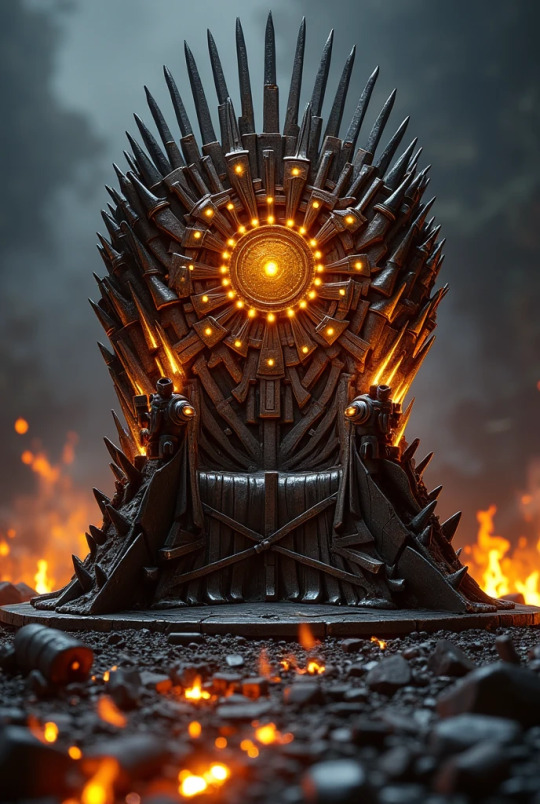
Chapter 1: The Forge of Dragonstone
The TWCT-T-D55 is no mere ironborn gadget. Cast in the Foundries of Valyrian Steel, it wields powers lost to lesser sensors:
Dragonflame Precision: Measures 200A with 1% accuracy—sharper than Oathkeeper’s edge.
Direwolf Stealth: Sips 5VA power, quieter than a Faceless Man’s breath.
Weirwood Endurance: Survives -25°C frosts and +70°C forge heat, unbroken by time or turmoil.
Why it shatters the old order:
Legacy CTs: Clumsy as Hodor, bumbling through phase shifts and kWh errors.
Shunt Resistors: Burn out faster than Viserys’ crown of gold.
Chapter 2: The War of Five Circuits
1. The Battle of Blackwater Bay (Smart Factories): TWCTs stalk energy vampires like Arya’s List, slashing waste with Needle-like precision. “Chaos isn’t a pit. It’s a $15k savings,” they whisper.
2. The Siege of Highgarden (Solar Farms): Guards solar arrays against hail storms and incompetence, steadfast as Brienne’s oath. “No panel left behind.”
3. The Red Wedding (EV Chargers): Halts faulty chargers mid-zap, sparing Teslas from becoming Dothraki funeral pyres. “The North remembers… proper grounding.”

The Words of House TWCT
“We Measure. We Endure. We Rule.”
Size: Slimmer than a Braavosi blade (55mm), deadlier than a Dornish spear.
Speed: Installs in 8 minutes—quicker than Bronn scaling a castle wall.
Cost: Cheaper than a Faceless Man’s contract, at $0.87 per kWh saved.
The Dragons of Innovation
AI Integration: TWCTs + Neural Networks = Tyrion-level wit. Predicts brownouts before Sansa’s lemon cakes melt.
Space Conquest: NASA arms Mars bases with radiation-hardened TWCTs. “Winter is coming… to the Red Planet.”
Meme Glory: “How it feels to use a Class 1 CT” + Direwolf pup in safety goggles. Viral before the Maester’s raven flies.
The Dark Threats Beyond the Wall
Legacy CTs: Bloat like Robert’s waistline, guzzling space and sanity.
Shunt Resistors: Fry circuits like wildfire at the Battle of the Blackwater.
The Prophecy of the Prince That Was Measured
Melisandre’s Vision: “A red star bleeds, and a sensor shall rise – precise as Dawn, unyielding as Ice. The TWCT-T-D55 shall unite the grid.”
Tyrion’s Toast: “A mind needs books. A circuit needs TWCTs. Without them, the realm plunges into darkness.”
Epilogue: Winter is Here (And It’s Electrified) To deny the TWCT-T-D55 is to court chaos—a realm of blackouts and burning budgets. The night is dark and full of inefficiencies.
References
The Song of Silicon & Sparks (Maester Luwin’s Tech Scrolls)
Fire & Wire: A History of Valyrian-Grade Sensors (Dragonstone Archives)
A Clash of Currents (King’s Landing Energy Reports)
1 note
·
View note
Text
DIRTY DRONE LOWLIFE + ECHOBLENDER #4 - a subbass/texture generator + experimental delay/distortion

The DIRTY DRONE LOWLIFE + ECHOBLENDER is an experimental subbass and drone texture generator combined with an experimental delay/distortion unit. It is housed in a recycled wooden box painted with broken hexagon (burned out industrial camo) patterns with a scratched dark grey aluminum face plate. The DIRTY DRONE LOWLIFE can be manually triggered by a TRIGGER button and externally with a TRIGGER/GATE input. The DECAY has a SHORT/LONG switch to select the range and a DECAY pot (works counterclockwise) to fine tune it, from snappy to loooong. An orange LED indicates triggers and the decay. With the DRONE toggle switch it can be set to play a constant drone sound as well. The sound is that of two oscillators each with an array of possible settings: TRIANGLE/SQUARE and CLEAN/DIRTY toggle switches and of course a FREQUENCY control. Oscillator 1 has an additional OFFSET control, that has a CV input with a very limited useful range from 1.6-2.6V (with an orange indicator LED). Both oscillators are mixed with the BLEND control, that allows to shape the output waveform in a relatively linear manner, but the build in LDRs (Light Dependent Resistors) can also used for that. When they are selected with the BLEND SELECT toggle switch ‘throwing shade’ or ‘shining light’ allows for a non-linear modulation of the blend, by hand gestures for example. The signal then runs through a resonant low pass filter with CUTOFF FREQUENCY, RESONANCE and SATURATION control. In the end of the signal chain is a VOLUME control. From there it either goes to the DRY OUT or if nothing is plugged into the DRY OUT to the ECHOBLENDER, which also as an input for an external signal, so it can be used independently from the LOWLIFE.
The ECHOBLENDER is based on the ���Echobender” by Casper Electronics with some tweaks for improved control. A device for dark echos (low pass filtered) and the ‘blackened’ noise of the internal distortion feedback. These machine is a delay/distortion bastard. Plus they kill fascists! The controls, from upper left to lower right: DRY VOLUME, FEEDBACK(DISTORTION), WET VOLUME, COARSE TIME, FINE TIME, REPEATS. It’s a true-bypass effect with a foot-switch and a ultraviolet indicator LED and an orange clipping/limiting diode in the feedback path to make better use of the self oscillations. Instead of just a blend pot, the ECHOBLENDER has two separate VOLUME pots for a precise mix of DRY and WET signal. With the WET at zero, the DRY also works as a signal BOOSTER to increase volume of the input signal. The FEEDBACK pot let’s you play with the self-oscillation and/or distortion capabilities of this versatile effect. With the DECAY fully clockwise you get classic delay self-oscillations. Get lost i a world of foggy delay noise clouds. Handmade by GRM for METSÄÄN.
Sold. Here's a demovideo of a previous build, the functions are identical:









2 notes
·
View notes
Text
Unlocking the Power of Resistance: Exploring Kanthal A1 and St. Kanthal A1 Wire
In the vast landscape of industrial materials, few substances have garnered as much attention and utility as the materials utilized in electrical heating systems. A notable player in this ensemble is Kanthal A1, an alloy celebrated for its impressive resistance, versatility, and durability. As industries increasingly seek efficient heating solutions, understanding the significance of this alloy and its applications becomes paramount. This article delves into the features and benefits of Kanthal A1 and the related St. Kanthal A1 Wire, illuminating their roles in various sectors.
The Properties of Kanthal A1
To appreciate the relevance of Kanthal A1, one must first grasp its composition and characteristics. Primarily made from iron, chromium, and aluminum, this alloy boasts remarkable resistance to high temperatures and oxidation. With a high resistivity, it effectively converts electrical energy into heat, making it ideal for a plethora of heating applications. Additionally, Kanthal A1 exhibits excellent mechanical properties, ensuring longevity and reliability in challenging environments. These properties enable it to withstand extreme thermal cycling, crucial in applications that demand rapid temperature changes. Understanding these characteristics establishes a foundation for recognizing its applications across various industries.
Applications and Industries Utilizing Kanthal A1
The versatile nature of Kanthal A1 translates into a wide array of applications. It has become a staple in industries ranging from manufacturing to food processing, where precise temperature control is essential. Electric heating elements, such as those used in industrial ovens, furnaces, and kilns, significantly benefit from the high performance offered by Kanthal A1. Furthermore, its anti-oxidation properties allow it to perform optimally even under extreme conditions, ensuring reliability in critical settings. The climbing demand for efficient heating solutions underlines the significance of this alloy, making it a focal point in the development of advanced heating technologies across various sectors.
The Role of St. Kanthal A1 Wire
In the realm of resistance materials, the St. Kanthal A1 Wire serves as an essential adaptation of the original Kanthal A1 alloy. This wire form retains the favorable properties of the alloy but offers additional flexibility and ease of use for several applications. It provides an adequate resistance-to-length ratio, making it highly suitable for use in coil heating elements, resistors, and heating elements for applications in both industrial and domestic realms. One of its notable applications is in the field of vaping, where users savor the refined heating attributes of the St. Kanthal A1 Wire for consistent vapor production and excellent flavor delivery. By understanding the unique characteristics of this wire, manufacturers and users alike can maximize their efficiency in heating applications.
Comparing Kanthal A1 to Other Alloys
When comparing Kanthal A1 to other heating elements, it emerges as a clear contender due to its superior thermal efficiency and oxidation resistance. Other materials, such as nickel-chromium alloys, may perform well under specific conditions; however, they often do not match the longevity and thermal performance of Kanthal A1. This becomes crucial in industrial environments where downtime caused by equipment failure can result in significant financial losses. As industries look toward increasing efficiency and reducing operational costs, the benefits of utilizing Kanthal A1 and St. Kanthal A1 Wire become evident in maintaining continuous and efficient operations.
The Future of Kanthal A1 and St. Kanthal A1 Wire
With ongoing advancements in materials science, the future of Kanthal A1 and its wire configuration looks promising. As technologies evolve, there is a rising emphasis on sustainability and energy efficiency within manufacturing processes. The thermal stability and high-performance characteristics of Kanthal A1 position it as a go-to solution for modern applications. This is particularly relevant in sectors actively transitioning towards greener technologies, where effective energy utilization is paramount. Continuous research into improving the properties and applications of St. Kanthal A1 Wire may lead to even wider adoption across various sectors, particularly in high-tech industries such as aerospace and electronics.
0 notes